Business Strategy Analysis: Vodafone's Internal and External Factors
VerifiedAdded on 2021/01/02
|13
|4911
|309
Report
AI Summary
This report provides a comprehensive analysis of Vodafone's business strategy. It begins with an introduction defining business strategy and Vodafone's market position. The report then examines the impact of the macro environment on Vodafone using the PESTLE model, considering political, economic, social, technological, legal, and environmental factors. Ansoff's growth matrix is applied to analyze Vodafone's strategic options, including market penetration, product development, and diversification. The internal environment is assessed, focusing on Vodafone's strategic capabilities and the application of the VRIO model to evaluate its resources. The report also evaluates the competitiveness of the UK's telecommunications sector using Porter's five forces model. Finally, the report analyzes Vodafone's strategic direction and options using Bowman's strategy clock model, concluding with a summary of findings and recommendations.
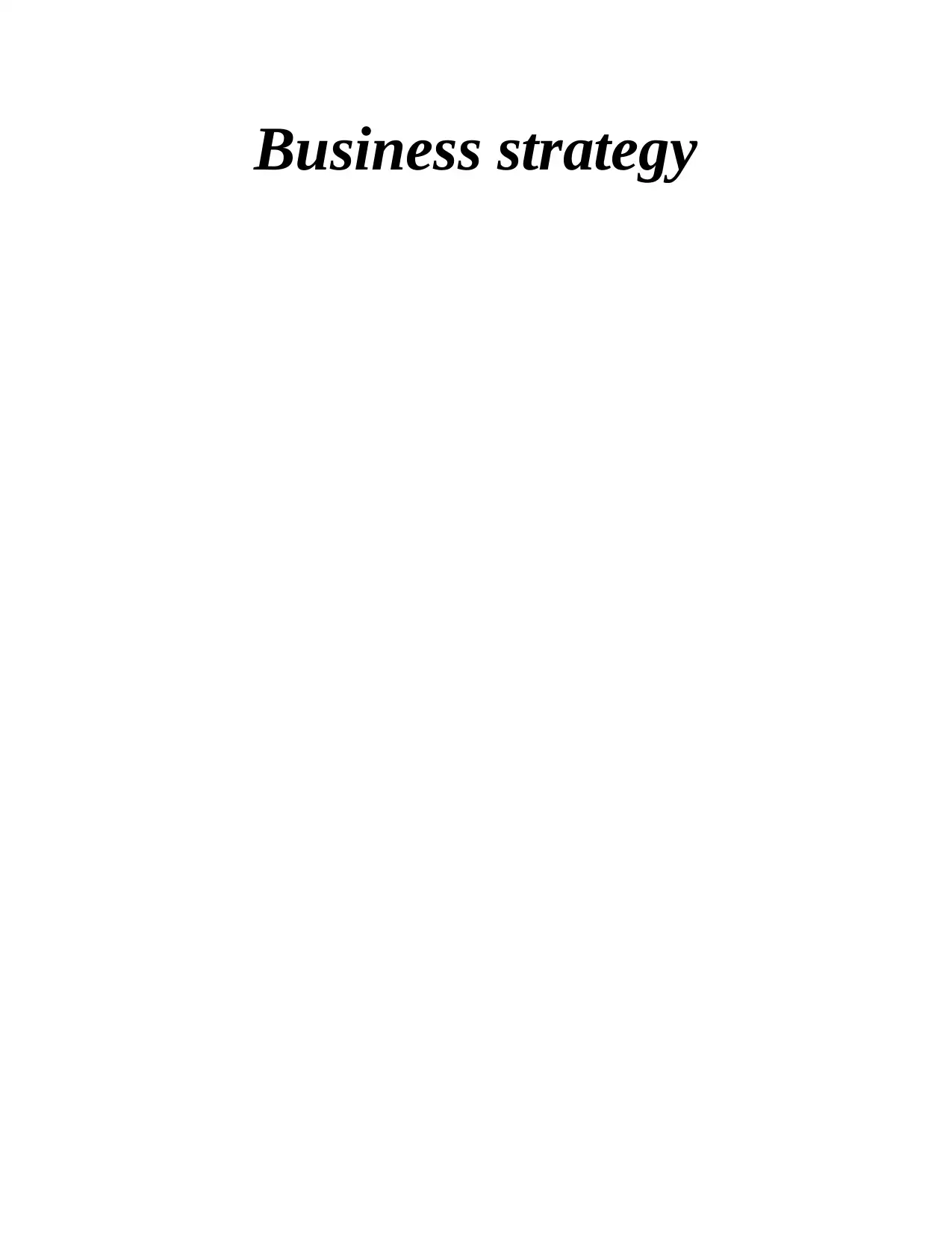
Business strategy
Paraphrase This Document
Need a fresh take? Get an instant paraphrase of this document with our AI Paraphraser
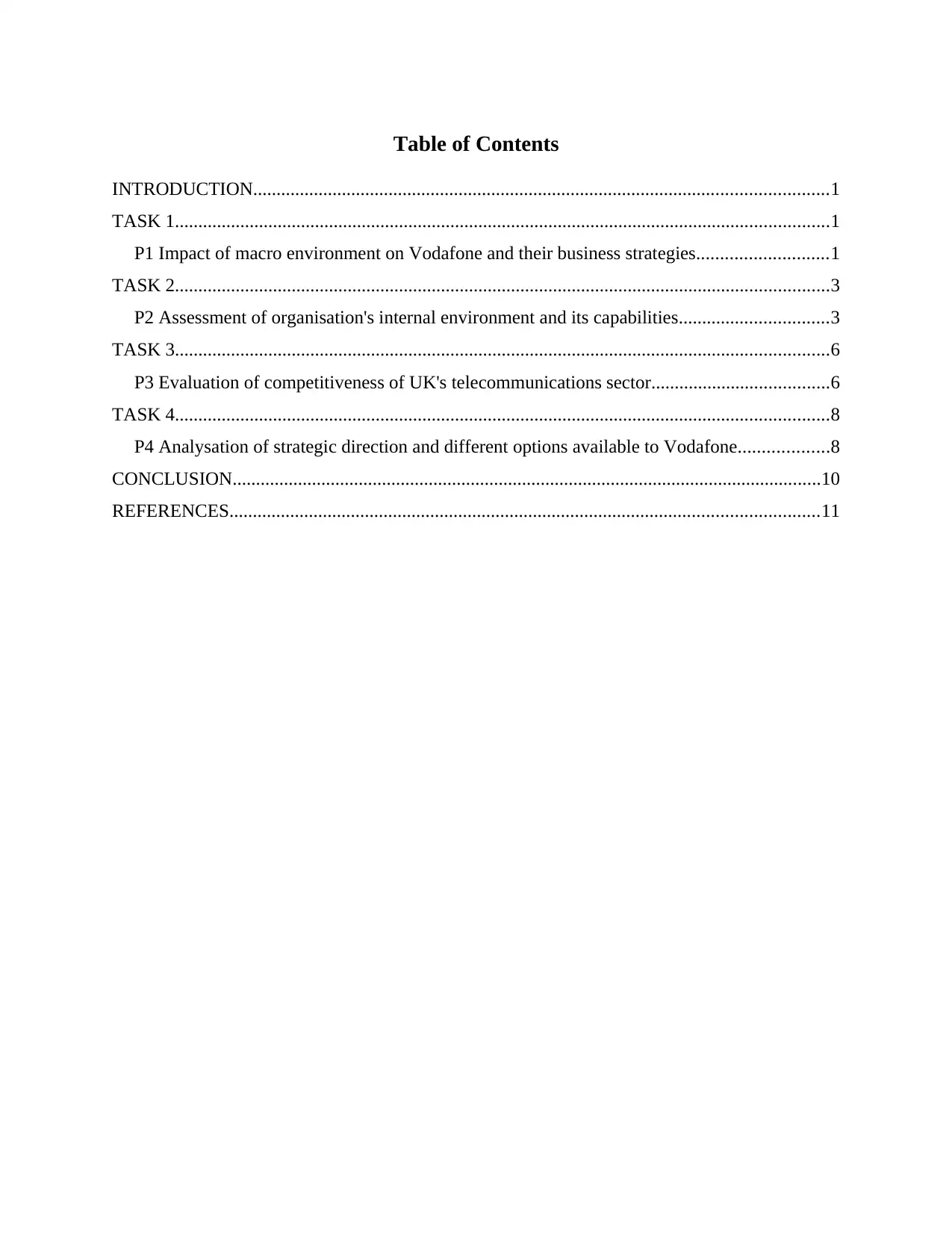
Table of Contents
INTRODUCTION...........................................................................................................................1
TASK 1............................................................................................................................................1
P1 Impact of macro environment on Vodafone and their business strategies............................1
TASK 2............................................................................................................................................3
P2 Assessment of organisation's internal environment and its capabilities................................3
TASK 3............................................................................................................................................6
P3 Evaluation of competitiveness of UK's telecommunications sector......................................6
TASK 4............................................................................................................................................8
P4 Analysation of strategic direction and different options available to Vodafone...................8
CONCLUSION..............................................................................................................................10
REFERENCES..............................................................................................................................11
INTRODUCTION...........................................................................................................................1
TASK 1............................................................................................................................................1
P1 Impact of macro environment on Vodafone and their business strategies............................1
TASK 2............................................................................................................................................3
P2 Assessment of organisation's internal environment and its capabilities................................3
TASK 3............................................................................................................................................6
P3 Evaluation of competitiveness of UK's telecommunications sector......................................6
TASK 4............................................................................................................................................8
P4 Analysation of strategic direction and different options available to Vodafone...................8
CONCLUSION..............................................................................................................................10
REFERENCES..............................................................................................................................11
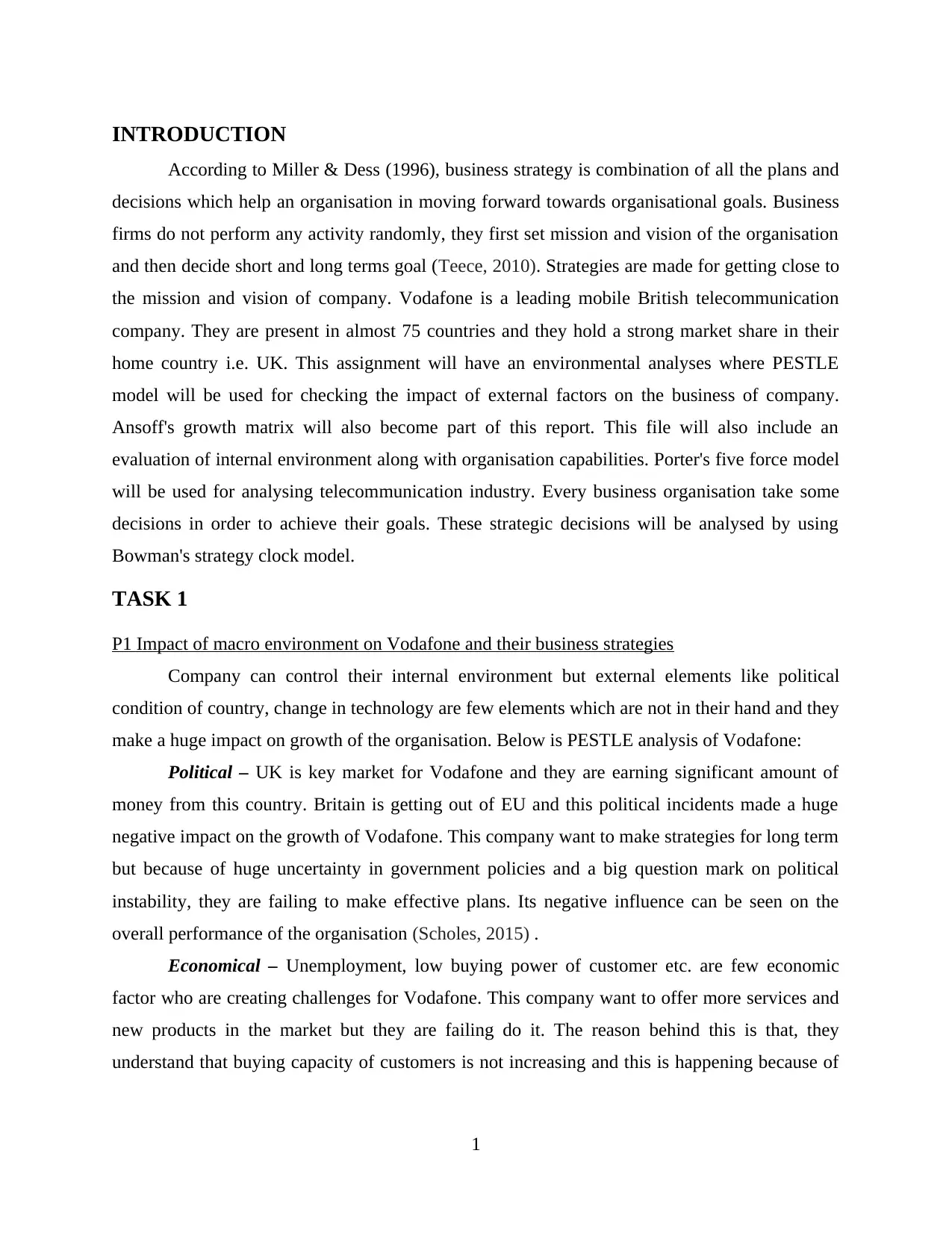
INTRODUCTION
According to Miller & Dess (1996), business strategy is combination of all the plans and
decisions which help an organisation in moving forward towards organisational goals. Business
firms do not perform any activity randomly, they first set mission and vision of the organisation
and then decide short and long terms goal (Teece, 2010). Strategies are made for getting close to
the mission and vision of company. Vodafone is a leading mobile British telecommunication
company. They are present in almost 75 countries and they hold a strong market share in their
home country i.e. UK. This assignment will have an environmental analyses where PESTLE
model will be used for checking the impact of external factors on the business of company.
Ansoff's growth matrix will also become part of this report. This file will also include an
evaluation of internal environment along with organisation capabilities. Porter's five force model
will be used for analysing telecommunication industry. Every business organisation take some
decisions in order to achieve their goals. These strategic decisions will be analysed by using
Bowman's strategy clock model.
TASK 1
P1 Impact of macro environment on Vodafone and their business strategies
Company can control their internal environment but external elements like political
condition of country, change in technology are few elements which are not in their hand and they
make a huge impact on growth of the organisation. Below is PESTLE analysis of Vodafone:
Political – UK is key market for Vodafone and they are earning significant amount of
money from this country. Britain is getting out of EU and this political incidents made a huge
negative impact on the growth of Vodafone. This company want to make strategies for long term
but because of huge uncertainty in government policies and a big question mark on political
instability, they are failing to make effective plans. Its negative influence can be seen on the
overall performance of the organisation (Scholes, 2015) .
Economical – Unemployment, low buying power of customer etc. are few economic
factor who are creating challenges for Vodafone. This company want to offer more services and
new products in the market but they are failing do it. The reason behind this is that, they
understand that buying capacity of customers is not increasing and this is happening because of
1
According to Miller & Dess (1996), business strategy is combination of all the plans and
decisions which help an organisation in moving forward towards organisational goals. Business
firms do not perform any activity randomly, they first set mission and vision of the organisation
and then decide short and long terms goal (Teece, 2010). Strategies are made for getting close to
the mission and vision of company. Vodafone is a leading mobile British telecommunication
company. They are present in almost 75 countries and they hold a strong market share in their
home country i.e. UK. This assignment will have an environmental analyses where PESTLE
model will be used for checking the impact of external factors on the business of company.
Ansoff's growth matrix will also become part of this report. This file will also include an
evaluation of internal environment along with organisation capabilities. Porter's five force model
will be used for analysing telecommunication industry. Every business organisation take some
decisions in order to achieve their goals. These strategic decisions will be analysed by using
Bowman's strategy clock model.
TASK 1
P1 Impact of macro environment on Vodafone and their business strategies
Company can control their internal environment but external elements like political
condition of country, change in technology are few elements which are not in their hand and they
make a huge impact on growth of the organisation. Below is PESTLE analysis of Vodafone:
Political – UK is key market for Vodafone and they are earning significant amount of
money from this country. Britain is getting out of EU and this political incidents made a huge
negative impact on the growth of Vodafone. This company want to make strategies for long term
but because of huge uncertainty in government policies and a big question mark on political
instability, they are failing to make effective plans. Its negative influence can be seen on the
overall performance of the organisation (Scholes, 2015) .
Economical – Unemployment, low buying power of customer etc. are few economic
factor who are creating challenges for Vodafone. This company want to offer more services and
new products in the market but they are failing do it. The reason behind this is that, they
understand that buying capacity of customers is not increasing and this is happening because of
1
⊘ This is a preview!⊘
Do you want full access?
Subscribe today to unlock all pages.

Trusted by 1+ million students worldwide
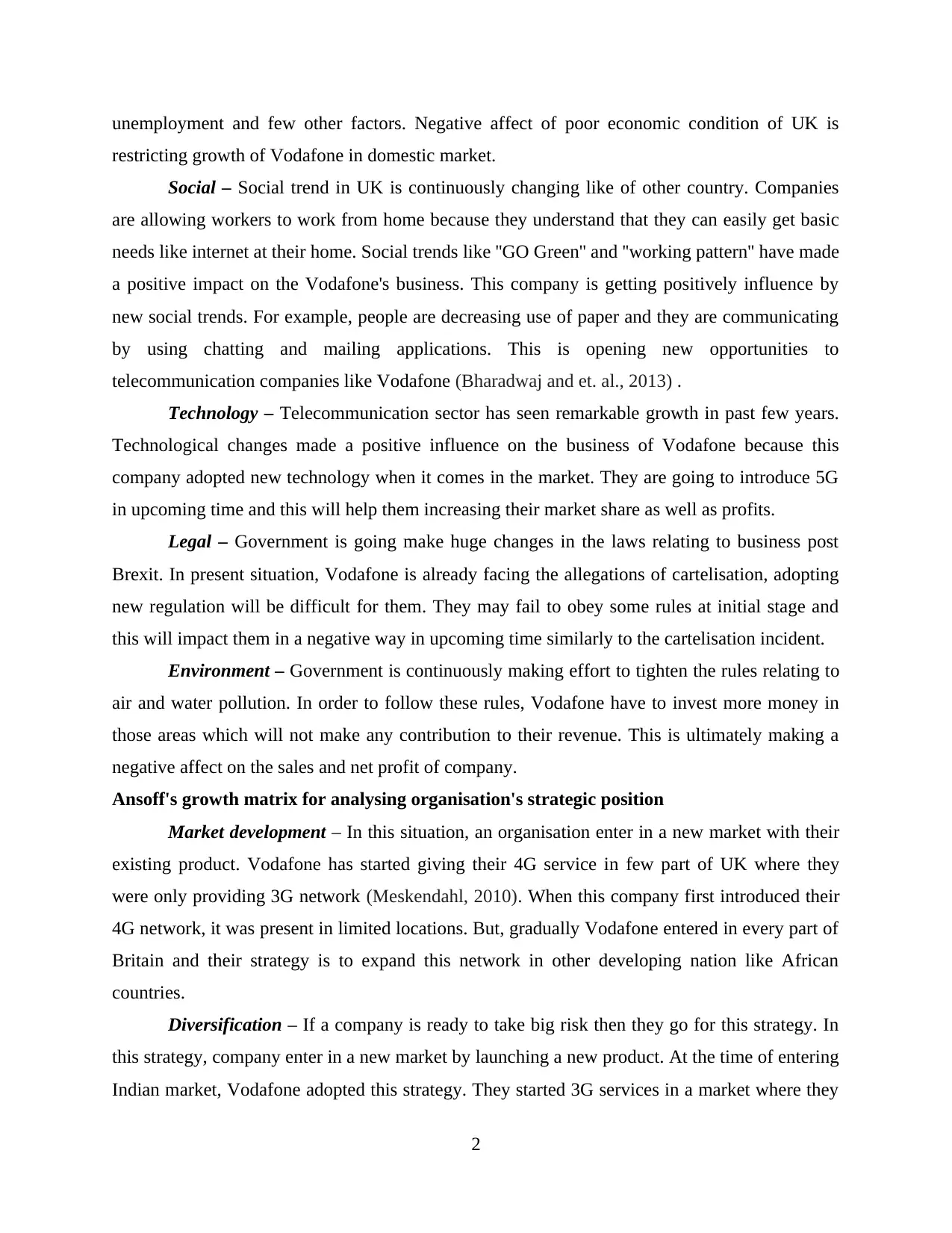
unemployment and few other factors. Negative affect of poor economic condition of UK is
restricting growth of Vodafone in domestic market.
Social – Social trend in UK is continuously changing like of other country. Companies
are allowing workers to work from home because they understand that they can easily get basic
needs like internet at their home. Social trends like ''GO Green'' and ''working pattern'' have made
a positive impact on the Vodafone's business. This company is getting positively influence by
new social trends. For example, people are decreasing use of paper and they are communicating
by using chatting and mailing applications. This is opening new opportunities to
telecommunication companies like Vodafone (Bharadwaj and et. al., 2013) .
Technology – Telecommunication sector has seen remarkable growth in past few years.
Technological changes made a positive influence on the business of Vodafone because this
company adopted new technology when it comes in the market. They are going to introduce 5G
in upcoming time and this will help them increasing their market share as well as profits.
Legal – Government is going make huge changes in the laws relating to business post
Brexit. In present situation, Vodafone is already facing the allegations of cartelisation, adopting
new regulation will be difficult for them. They may fail to obey some rules at initial stage and
this will impact them in a negative way in upcoming time similarly to the cartelisation incident.
Environment – Government is continuously making effort to tighten the rules relating to
air and water pollution. In order to follow these rules, Vodafone have to invest more money in
those areas which will not make any contribution to their revenue. This is ultimately making a
negative affect on the sales and net profit of company.
Ansoff's growth matrix for analysing organisation's strategic position
Market development – In this situation, an organisation enter in a new market with their
existing product. Vodafone has started giving their 4G service in few part of UK where they
were only providing 3G network (Meskendahl, 2010). When this company first introduced their
4G network, it was present in limited locations. But, gradually Vodafone entered in every part of
Britain and their strategy is to expand this network in other developing nation like African
countries.
Diversification – If a company is ready to take big risk then they go for this strategy. In
this strategy, company enter in a new market by launching a new product. At the time of entering
Indian market, Vodafone adopted this strategy. They started 3G services in a market where they
2
restricting growth of Vodafone in domestic market.
Social – Social trend in UK is continuously changing like of other country. Companies
are allowing workers to work from home because they understand that they can easily get basic
needs like internet at their home. Social trends like ''GO Green'' and ''working pattern'' have made
a positive impact on the Vodafone's business. This company is getting positively influence by
new social trends. For example, people are decreasing use of paper and they are communicating
by using chatting and mailing applications. This is opening new opportunities to
telecommunication companies like Vodafone (Bharadwaj and et. al., 2013) .
Technology – Telecommunication sector has seen remarkable growth in past few years.
Technological changes made a positive influence on the business of Vodafone because this
company adopted new technology when it comes in the market. They are going to introduce 5G
in upcoming time and this will help them increasing their market share as well as profits.
Legal – Government is going make huge changes in the laws relating to business post
Brexit. In present situation, Vodafone is already facing the allegations of cartelisation, adopting
new regulation will be difficult for them. They may fail to obey some rules at initial stage and
this will impact them in a negative way in upcoming time similarly to the cartelisation incident.
Environment – Government is continuously making effort to tighten the rules relating to
air and water pollution. In order to follow these rules, Vodafone have to invest more money in
those areas which will not make any contribution to their revenue. This is ultimately making a
negative affect on the sales and net profit of company.
Ansoff's growth matrix for analysing organisation's strategic position
Market development – In this situation, an organisation enter in a new market with their
existing product. Vodafone has started giving their 4G service in few part of UK where they
were only providing 3G network (Meskendahl, 2010). When this company first introduced their
4G network, it was present in limited locations. But, gradually Vodafone entered in every part of
Britain and their strategy is to expand this network in other developing nation like African
countries.
Diversification – If a company is ready to take big risk then they go for this strategy. In
this strategy, company enter in a new market by launching a new product. At the time of entering
Indian market, Vodafone adopted this strategy. They started 3G services in a market where they
2
Paraphrase This Document
Need a fresh take? Get an instant paraphrase of this document with our AI Paraphraser
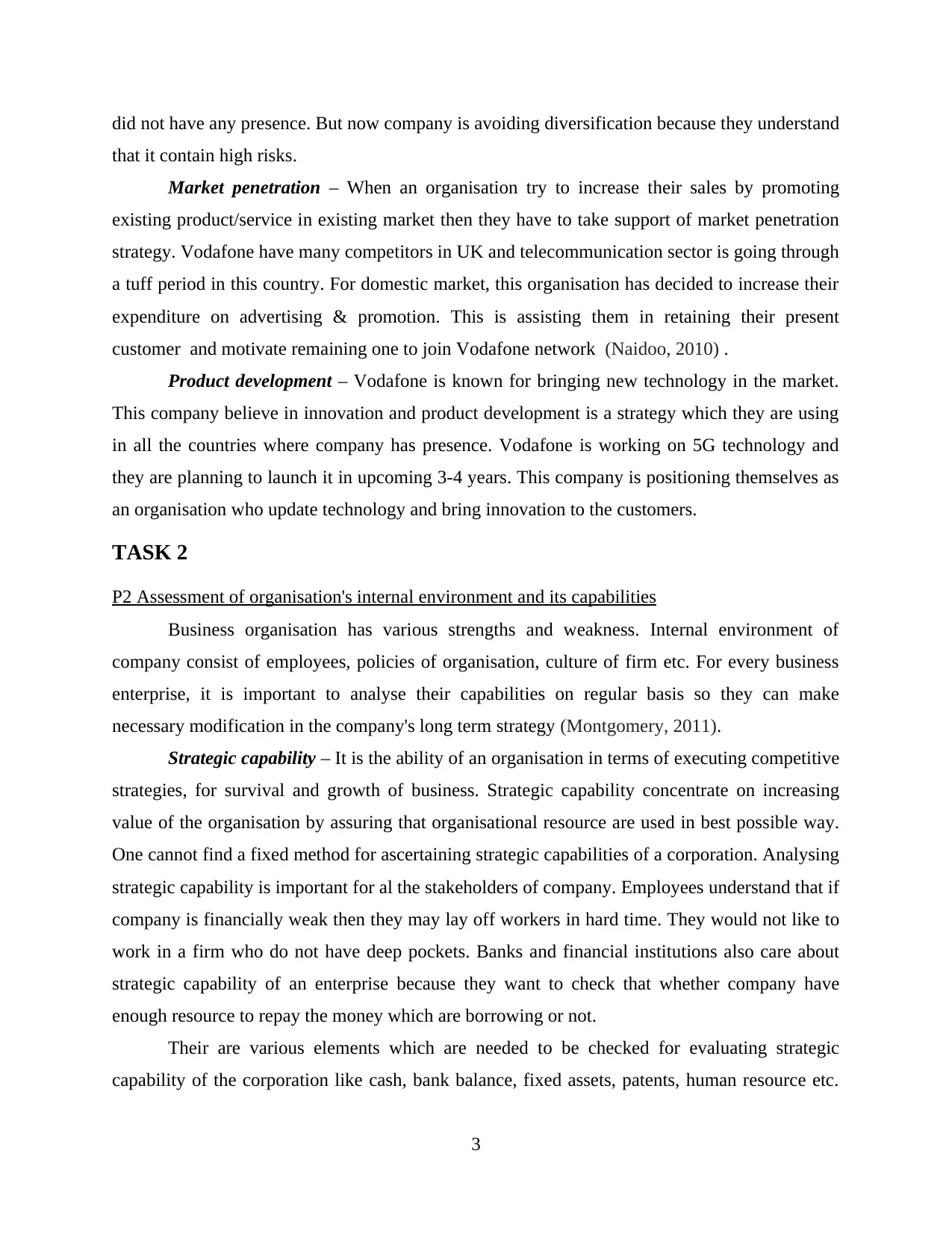
did not have any presence. But now company is avoiding diversification because they understand
that it contain high risks.
Market penetration – When an organisation try to increase their sales by promoting
existing product/service in existing market then they have to take support of market penetration
strategy. Vodafone have many competitors in UK and telecommunication sector is going through
a tuff period in this country. For domestic market, this organisation has decided to increase their
expenditure on advertising & promotion. This is assisting them in retaining their present
customer and motivate remaining one to join Vodafone network (Naidoo, 2010) .
Product development – Vodafone is known for bringing new technology in the market.
This company believe in innovation and product development is a strategy which they are using
in all the countries where company has presence. Vodafone is working on 5G technology and
they are planning to launch it in upcoming 3-4 years. This company is positioning themselves as
an organisation who update technology and bring innovation to the customers.
TASK 2
P2 Assessment of organisation's internal environment and its capabilities
Business organisation has various strengths and weakness. Internal environment of
company consist of employees, policies of organisation, culture of firm etc. For every business
enterprise, it is important to analyse their capabilities on regular basis so they can make
necessary modification in the company's long term strategy (Montgomery, 2011).
Strategic capability – It is the ability of an organisation in terms of executing competitive
strategies, for survival and growth of business. Strategic capability concentrate on increasing
value of the organisation by assuring that organisational resource are used in best possible way.
One cannot find a fixed method for ascertaining strategic capabilities of a corporation. Analysing
strategic capability is important for al the stakeholders of company. Employees understand that if
company is financially weak then they may lay off workers in hard time. They would not like to
work in a firm who do not have deep pockets. Banks and financial institutions also care about
strategic capability of an enterprise because they want to check that whether company have
enough resource to repay the money which are borrowing or not.
Their are various elements which are needed to be checked for evaluating strategic
capability of the corporation like cash, bank balance, fixed assets, patents, human resource etc.
3
that it contain high risks.
Market penetration – When an organisation try to increase their sales by promoting
existing product/service in existing market then they have to take support of market penetration
strategy. Vodafone have many competitors in UK and telecommunication sector is going through
a tuff period in this country. For domestic market, this organisation has decided to increase their
expenditure on advertising & promotion. This is assisting them in retaining their present
customer and motivate remaining one to join Vodafone network (Naidoo, 2010) .
Product development – Vodafone is known for bringing new technology in the market.
This company believe in innovation and product development is a strategy which they are using
in all the countries where company has presence. Vodafone is working on 5G technology and
they are planning to launch it in upcoming 3-4 years. This company is positioning themselves as
an organisation who update technology and bring innovation to the customers.
TASK 2
P2 Assessment of organisation's internal environment and its capabilities
Business organisation has various strengths and weakness. Internal environment of
company consist of employees, policies of organisation, culture of firm etc. For every business
enterprise, it is important to analyse their capabilities on regular basis so they can make
necessary modification in the company's long term strategy (Montgomery, 2011).
Strategic capability – It is the ability of an organisation in terms of executing competitive
strategies, for survival and growth of business. Strategic capability concentrate on increasing
value of the organisation by assuring that organisational resource are used in best possible way.
One cannot find a fixed method for ascertaining strategic capabilities of a corporation. Analysing
strategic capability is important for al the stakeholders of company. Employees understand that if
company is financially weak then they may lay off workers in hard time. They would not like to
work in a firm who do not have deep pockets. Banks and financial institutions also care about
strategic capability of an enterprise because they want to check that whether company have
enough resource to repay the money which are borrowing or not.
Their are various elements which are needed to be checked for evaluating strategic
capability of the corporation like cash, bank balance, fixed assets, patents, human resource etc.
3
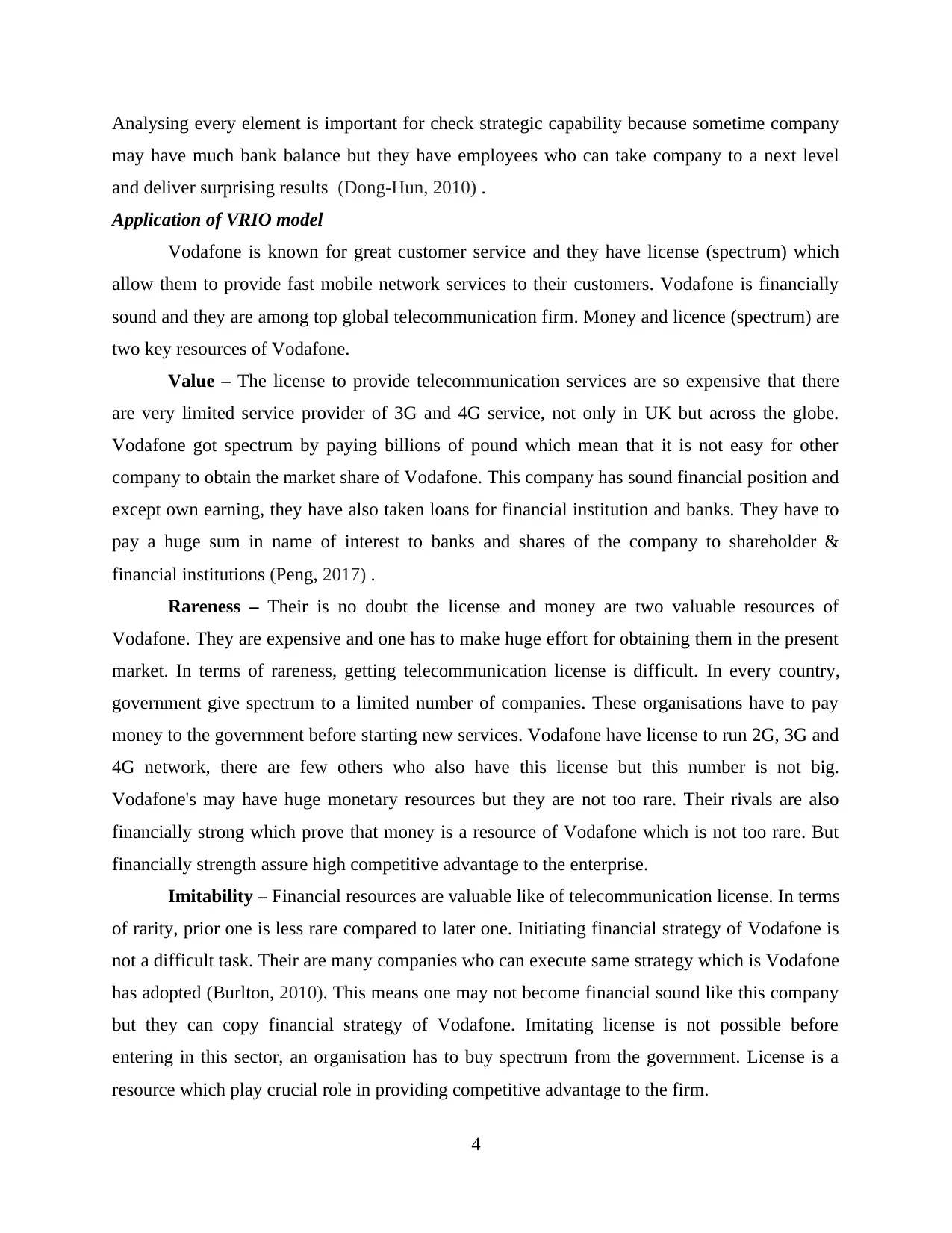
Analysing every element is important for check strategic capability because sometime company
may have much bank balance but they have employees who can take company to a next level
and deliver surprising results (Dong-Hun, 2010) .
Application of VRIO model
Vodafone is known for great customer service and they have license (spectrum) which
allow them to provide fast mobile network services to their customers. Vodafone is financially
sound and they are among top global telecommunication firm. Money and licence (spectrum) are
two key resources of Vodafone.
Value – The license to provide telecommunication services are so expensive that there
are very limited service provider of 3G and 4G service, not only in UK but across the globe.
Vodafone got spectrum by paying billions of pound which mean that it is not easy for other
company to obtain the market share of Vodafone. This company has sound financial position and
except own earning, they have also taken loans for financial institution and banks. They have to
pay a huge sum in name of interest to banks and shares of the company to shareholder &
financial institutions (Peng, 2017) .
Rareness – Their is no doubt the license and money are two valuable resources of
Vodafone. They are expensive and one has to make huge effort for obtaining them in the present
market. In terms of rareness, getting telecommunication license is difficult. In every country,
government give spectrum to a limited number of companies. These organisations have to pay
money to the government before starting new services. Vodafone have license to run 2G, 3G and
4G network, there are few others who also have this license but this number is not big.
Vodafone's may have huge monetary resources but they are not too rare. Their rivals are also
financially strong which prove that money is a resource of Vodafone which is not too rare. But
financially strength assure high competitive advantage to the enterprise.
Imitability – Financial resources are valuable like of telecommunication license. In terms
of rarity, prior one is less rare compared to later one. Initiating financial strategy of Vodafone is
not a difficult task. Their are many companies who can execute same strategy which is Vodafone
has adopted (Burlton, 2010). This means one may not become financial sound like this company
but they can copy financial strategy of Vodafone. Imitating license is not possible before
entering in this sector, an organisation has to buy spectrum from the government. License is a
resource which play crucial role in providing competitive advantage to the firm.
4
may have much bank balance but they have employees who can take company to a next level
and deliver surprising results (Dong-Hun, 2010) .
Application of VRIO model
Vodafone is known for great customer service and they have license (spectrum) which
allow them to provide fast mobile network services to their customers. Vodafone is financially
sound and they are among top global telecommunication firm. Money and licence (spectrum) are
two key resources of Vodafone.
Value – The license to provide telecommunication services are so expensive that there
are very limited service provider of 3G and 4G service, not only in UK but across the globe.
Vodafone got spectrum by paying billions of pound which mean that it is not easy for other
company to obtain the market share of Vodafone. This company has sound financial position and
except own earning, they have also taken loans for financial institution and banks. They have to
pay a huge sum in name of interest to banks and shares of the company to shareholder &
financial institutions (Peng, 2017) .
Rareness – Their is no doubt the license and money are two valuable resources of
Vodafone. They are expensive and one has to make huge effort for obtaining them in the present
market. In terms of rareness, getting telecommunication license is difficult. In every country,
government give spectrum to a limited number of companies. These organisations have to pay
money to the government before starting new services. Vodafone have license to run 2G, 3G and
4G network, there are few others who also have this license but this number is not big.
Vodafone's may have huge monetary resources but they are not too rare. Their rivals are also
financially strong which prove that money is a resource of Vodafone which is not too rare. But
financially strength assure high competitive advantage to the enterprise.
Imitability – Financial resources are valuable like of telecommunication license. In terms
of rarity, prior one is less rare compared to later one. Initiating financial strategy of Vodafone is
not a difficult task. Their are many companies who can execute same strategy which is Vodafone
has adopted (Burlton, 2010). This means one may not become financial sound like this company
but they can copy financial strategy of Vodafone. Imitating license is not possible before
entering in this sector, an organisation has to buy spectrum from the government. License is a
resource which play crucial role in providing competitive advantage to the firm.
4
⊘ This is a preview!⊘
Do you want full access?
Subscribe today to unlock all pages.

Trusted by 1+ million students worldwide
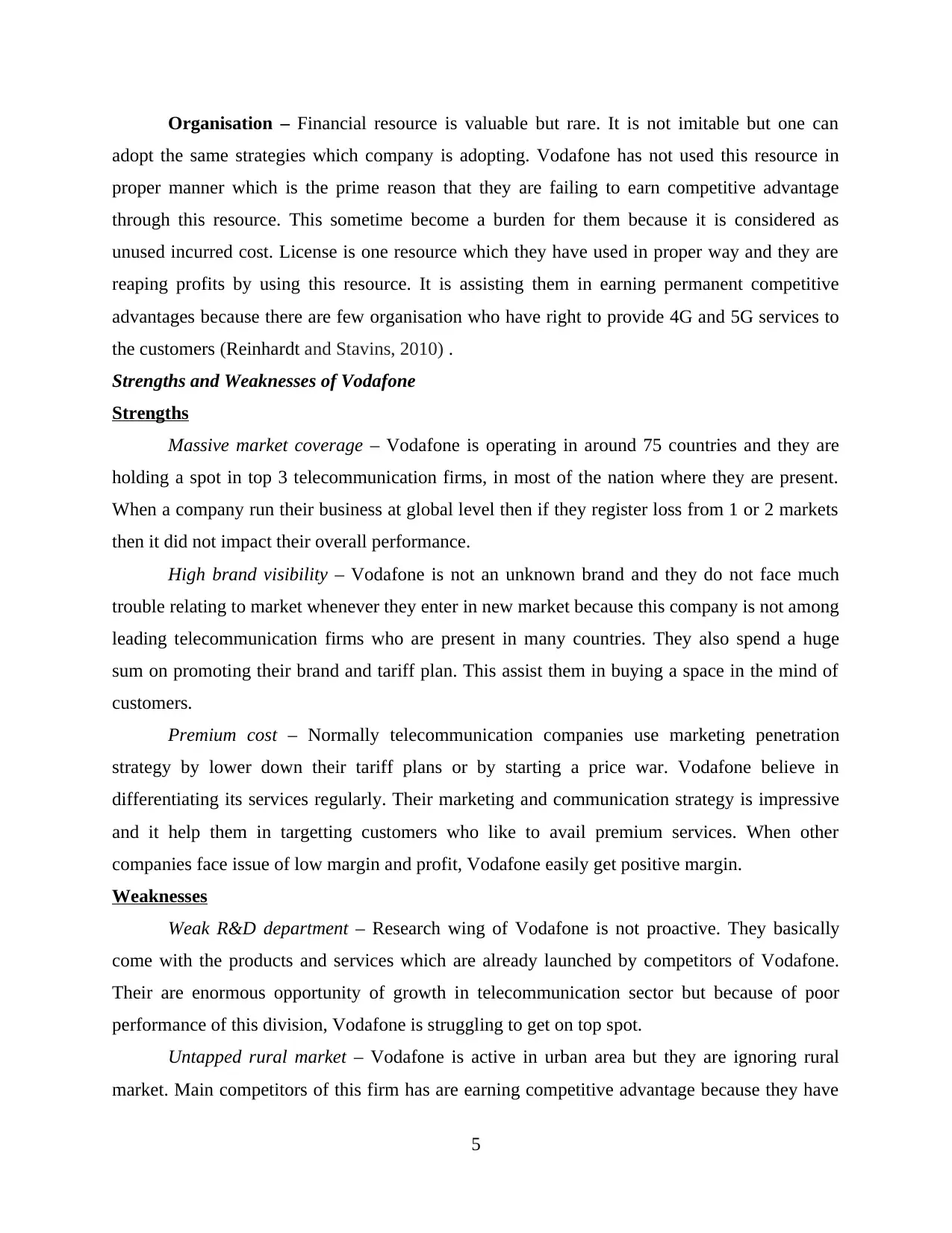
Organisation – Financial resource is valuable but rare. It is not imitable but one can
adopt the same strategies which company is adopting. Vodafone has not used this resource in
proper manner which is the prime reason that they are failing to earn competitive advantage
through this resource. This sometime become a burden for them because it is considered as
unused incurred cost. License is one resource which they have used in proper way and they are
reaping profits by using this resource. It is assisting them in earning permanent competitive
advantages because there are few organisation who have right to provide 4G and 5G services to
the customers (Reinhardt and Stavins, 2010) .
Strengths and Weaknesses of Vodafone
Strengths
Massive market coverage – Vodafone is operating in around 75 countries and they are
holding a spot in top 3 telecommunication firms, in most of the nation where they are present.
When a company run their business at global level then if they register loss from 1 or 2 markets
then it did not impact their overall performance.
High brand visibility – Vodafone is not an unknown brand and they do not face much
trouble relating to market whenever they enter in new market because this company is not among
leading telecommunication firms who are present in many countries. They also spend a huge
sum on promoting their brand and tariff plan. This assist them in buying a space in the mind of
customers.
Premium cost – Normally telecommunication companies use marketing penetration
strategy by lower down their tariff plans or by starting a price war. Vodafone believe in
differentiating its services regularly. Their marketing and communication strategy is impressive
and it help them in targetting customers who like to avail premium services. When other
companies face issue of low margin and profit, Vodafone easily get positive margin.
Weaknesses
Weak R&D department – Research wing of Vodafone is not proactive. They basically
come with the products and services which are already launched by competitors of Vodafone.
Their are enormous opportunity of growth in telecommunication sector but because of poor
performance of this division, Vodafone is struggling to get on top spot.
Untapped rural market – Vodafone is active in urban area but they are ignoring rural
market. Main competitors of this firm has are earning competitive advantage because they have
5
adopt the same strategies which company is adopting. Vodafone has not used this resource in
proper manner which is the prime reason that they are failing to earn competitive advantage
through this resource. This sometime become a burden for them because it is considered as
unused incurred cost. License is one resource which they have used in proper way and they are
reaping profits by using this resource. It is assisting them in earning permanent competitive
advantages because there are few organisation who have right to provide 4G and 5G services to
the customers (Reinhardt and Stavins, 2010) .
Strengths and Weaknesses of Vodafone
Strengths
Massive market coverage – Vodafone is operating in around 75 countries and they are
holding a spot in top 3 telecommunication firms, in most of the nation where they are present.
When a company run their business at global level then if they register loss from 1 or 2 markets
then it did not impact their overall performance.
High brand visibility – Vodafone is not an unknown brand and they do not face much
trouble relating to market whenever they enter in new market because this company is not among
leading telecommunication firms who are present in many countries. They also spend a huge
sum on promoting their brand and tariff plan. This assist them in buying a space in the mind of
customers.
Premium cost – Normally telecommunication companies use marketing penetration
strategy by lower down their tariff plans or by starting a price war. Vodafone believe in
differentiating its services regularly. Their marketing and communication strategy is impressive
and it help them in targetting customers who like to avail premium services. When other
companies face issue of low margin and profit, Vodafone easily get positive margin.
Weaknesses
Weak R&D department – Research wing of Vodafone is not proactive. They basically
come with the products and services which are already launched by competitors of Vodafone.
Their are enormous opportunity of growth in telecommunication sector but because of poor
performance of this division, Vodafone is struggling to get on top spot.
Untapped rural market – Vodafone is active in urban area but they are ignoring rural
market. Main competitors of this firm has are earning competitive advantage because they have
5
Paraphrase This Document
Need a fresh take? Get an instant paraphrase of this document with our AI Paraphraser
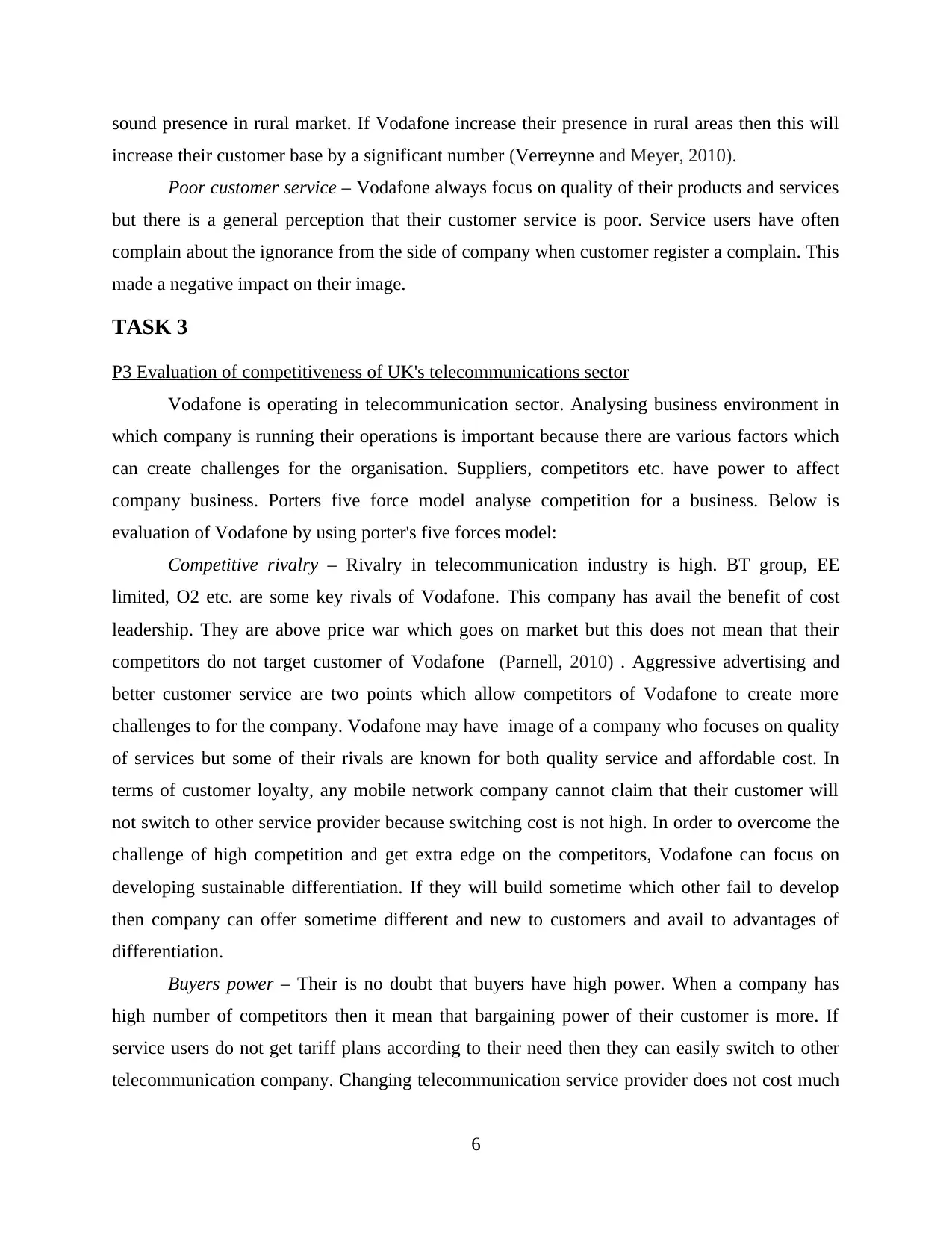
sound presence in rural market. If Vodafone increase their presence in rural areas then this will
increase their customer base by a significant number (Verreynne and Meyer, 2010).
Poor customer service – Vodafone always focus on quality of their products and services
but there is a general perception that their customer service is poor. Service users have often
complain about the ignorance from the side of company when customer register a complain. This
made a negative impact on their image.
TASK 3
P3 Evaluation of competitiveness of UK's telecommunications sector
Vodafone is operating in telecommunication sector. Analysing business environment in
which company is running their operations is important because there are various factors which
can create challenges for the organisation. Suppliers, competitors etc. have power to affect
company business. Porters five force model analyse competition for a business. Below is
evaluation of Vodafone by using porter's five forces model:
Competitive rivalry – Rivalry in telecommunication industry is high. BT group, EE
limited, O2 etc. are some key rivals of Vodafone. This company has avail the benefit of cost
leadership. They are above price war which goes on market but this does not mean that their
competitors do not target customer of Vodafone (Parnell, 2010) . Aggressive advertising and
better customer service are two points which allow competitors of Vodafone to create more
challenges to for the company. Vodafone may have image of a company who focuses on quality
of services but some of their rivals are known for both quality service and affordable cost. In
terms of customer loyalty, any mobile network company cannot claim that their customer will
not switch to other service provider because switching cost is not high. In order to overcome the
challenge of high competition and get extra edge on the competitors, Vodafone can focus on
developing sustainable differentiation. If they will build sometime which other fail to develop
then company can offer sometime different and new to customers and avail to advantages of
differentiation.
Buyers power – Their is no doubt that buyers have high power. When a company has
high number of competitors then it mean that bargaining power of their customer is more. If
service users do not get tariff plans according to their need then they can easily switch to other
telecommunication company. Changing telecommunication service provider does not cost much
6
increase their customer base by a significant number (Verreynne and Meyer, 2010).
Poor customer service – Vodafone always focus on quality of their products and services
but there is a general perception that their customer service is poor. Service users have often
complain about the ignorance from the side of company when customer register a complain. This
made a negative impact on their image.
TASK 3
P3 Evaluation of competitiveness of UK's telecommunications sector
Vodafone is operating in telecommunication sector. Analysing business environment in
which company is running their operations is important because there are various factors which
can create challenges for the organisation. Suppliers, competitors etc. have power to affect
company business. Porters five force model analyse competition for a business. Below is
evaluation of Vodafone by using porter's five forces model:
Competitive rivalry – Rivalry in telecommunication industry is high. BT group, EE
limited, O2 etc. are some key rivals of Vodafone. This company has avail the benefit of cost
leadership. They are above price war which goes on market but this does not mean that their
competitors do not target customer of Vodafone (Parnell, 2010) . Aggressive advertising and
better customer service are two points which allow competitors of Vodafone to create more
challenges to for the company. Vodafone may have image of a company who focuses on quality
of services but some of their rivals are known for both quality service and affordable cost. In
terms of customer loyalty, any mobile network company cannot claim that their customer will
not switch to other service provider because switching cost is not high. In order to overcome the
challenge of high competition and get extra edge on the competitors, Vodafone can focus on
developing sustainable differentiation. If they will build sometime which other fail to develop
then company can offer sometime different and new to customers and avail to advantages of
differentiation.
Buyers power – Their is no doubt that buyers have high power. When a company has
high number of competitors then it mean that bargaining power of their customer is more. If
service users do not get tariff plans according to their need then they can easily switch to other
telecommunication company. Changing telecommunication service provider does not cost much
6
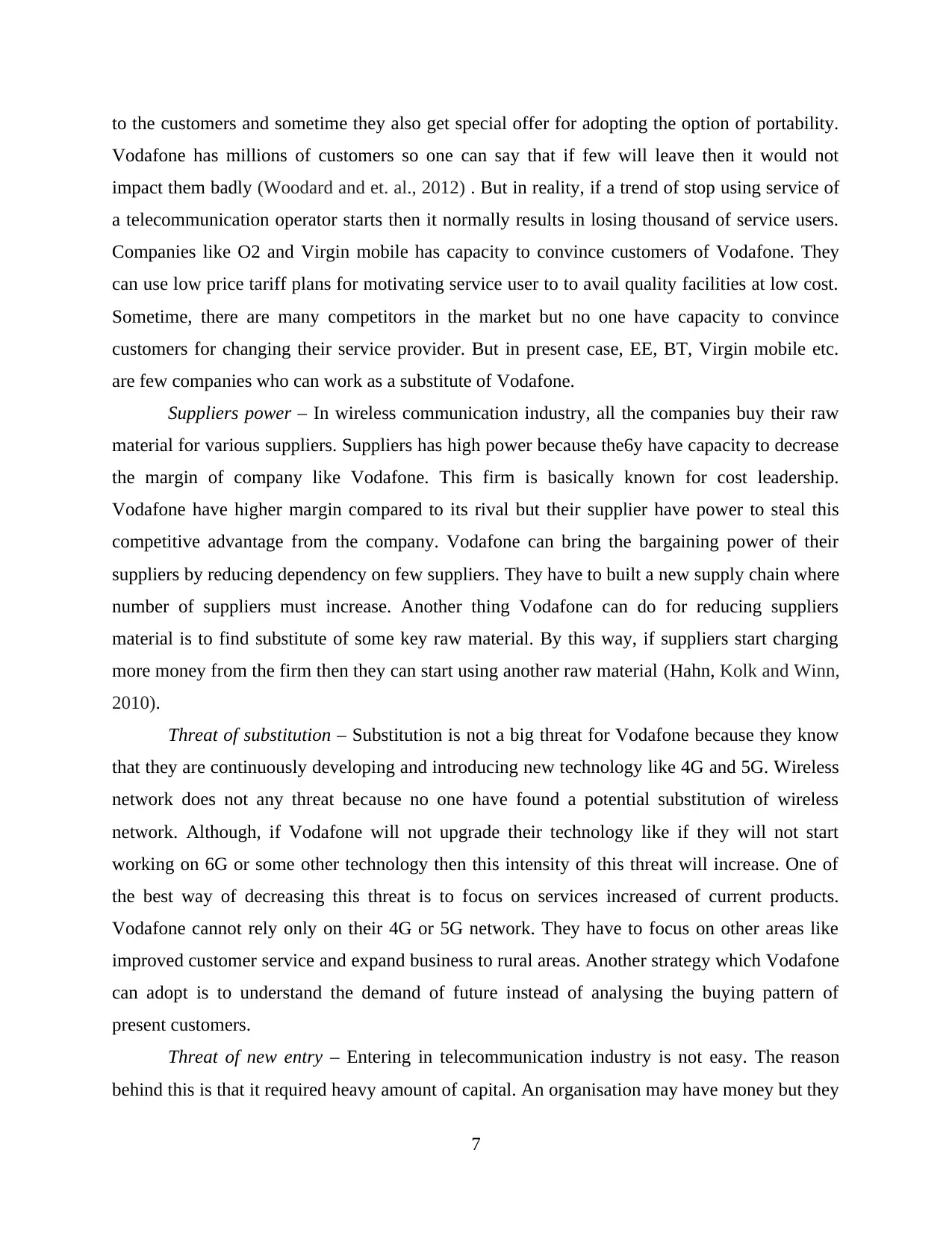
to the customers and sometime they also get special offer for adopting the option of portability.
Vodafone has millions of customers so one can say that if few will leave then it would not
impact them badly (Woodard and et. al., 2012) . But in reality, if a trend of stop using service of
a telecommunication operator starts then it normally results in losing thousand of service users.
Companies like O2 and Virgin mobile has capacity to convince customers of Vodafone. They
can use low price tariff plans for motivating service user to to avail quality facilities at low cost.
Sometime, there are many competitors in the market but no one have capacity to convince
customers for changing their service provider. But in present case, EE, BT, Virgin mobile etc.
are few companies who can work as a substitute of Vodafone.
Suppliers power – In wireless communication industry, all the companies buy their raw
material for various suppliers. Suppliers has high power because the6y have capacity to decrease
the margin of company like Vodafone. This firm is basically known for cost leadership.
Vodafone have higher margin compared to its rival but their supplier have power to steal this
competitive advantage from the company. Vodafone can bring the bargaining power of their
suppliers by reducing dependency on few suppliers. They have to built a new supply chain where
number of suppliers must increase. Another thing Vodafone can do for reducing suppliers
material is to find substitute of some key raw material. By this way, if suppliers start charging
more money from the firm then they can start using another raw material (Hahn, Kolk and Winn,
2010).
Threat of substitution – Substitution is not a big threat for Vodafone because they know
that they are continuously developing and introducing new technology like 4G and 5G. Wireless
network does not any threat because no one have found a potential substitution of wireless
network. Although, if Vodafone will not upgrade their technology like if they will not start
working on 6G or some other technology then this intensity of this threat will increase. One of
the best way of decreasing this threat is to focus on services increased of current products.
Vodafone cannot rely only on their 4G or 5G network. They have to focus on other areas like
improved customer service and expand business to rural areas. Another strategy which Vodafone
can adopt is to understand the demand of future instead of analysing the buying pattern of
present customers.
Threat of new entry – Entering in telecommunication industry is not easy. The reason
behind this is that it required heavy amount of capital. An organisation may have money but they
7
Vodafone has millions of customers so one can say that if few will leave then it would not
impact them badly (Woodard and et. al., 2012) . But in reality, if a trend of stop using service of
a telecommunication operator starts then it normally results in losing thousand of service users.
Companies like O2 and Virgin mobile has capacity to convince customers of Vodafone. They
can use low price tariff plans for motivating service user to to avail quality facilities at low cost.
Sometime, there are many competitors in the market but no one have capacity to convince
customers for changing their service provider. But in present case, EE, BT, Virgin mobile etc.
are few companies who can work as a substitute of Vodafone.
Suppliers power – In wireless communication industry, all the companies buy their raw
material for various suppliers. Suppliers has high power because the6y have capacity to decrease
the margin of company like Vodafone. This firm is basically known for cost leadership.
Vodafone have higher margin compared to its rival but their supplier have power to steal this
competitive advantage from the company. Vodafone can bring the bargaining power of their
suppliers by reducing dependency on few suppliers. They have to built a new supply chain where
number of suppliers must increase. Another thing Vodafone can do for reducing suppliers
material is to find substitute of some key raw material. By this way, if suppliers start charging
more money from the firm then they can start using another raw material (Hahn, Kolk and Winn,
2010).
Threat of substitution – Substitution is not a big threat for Vodafone because they know
that they are continuously developing and introducing new technology like 4G and 5G. Wireless
network does not any threat because no one have found a potential substitution of wireless
network. Although, if Vodafone will not upgrade their technology like if they will not start
working on 6G or some other technology then this intensity of this threat will increase. One of
the best way of decreasing this threat is to focus on services increased of current products.
Vodafone cannot rely only on their 4G or 5G network. They have to focus on other areas like
improved customer service and expand business to rural areas. Another strategy which Vodafone
can adopt is to understand the demand of future instead of analysing the buying pattern of
present customers.
Threat of new entry – Entering in telecommunication industry is not easy. The reason
behind this is that it required heavy amount of capital. An organisation may have money but they
7
⊘ This is a preview!⊘
Do you want full access?
Subscribe today to unlock all pages.

Trusted by 1+ million students worldwide
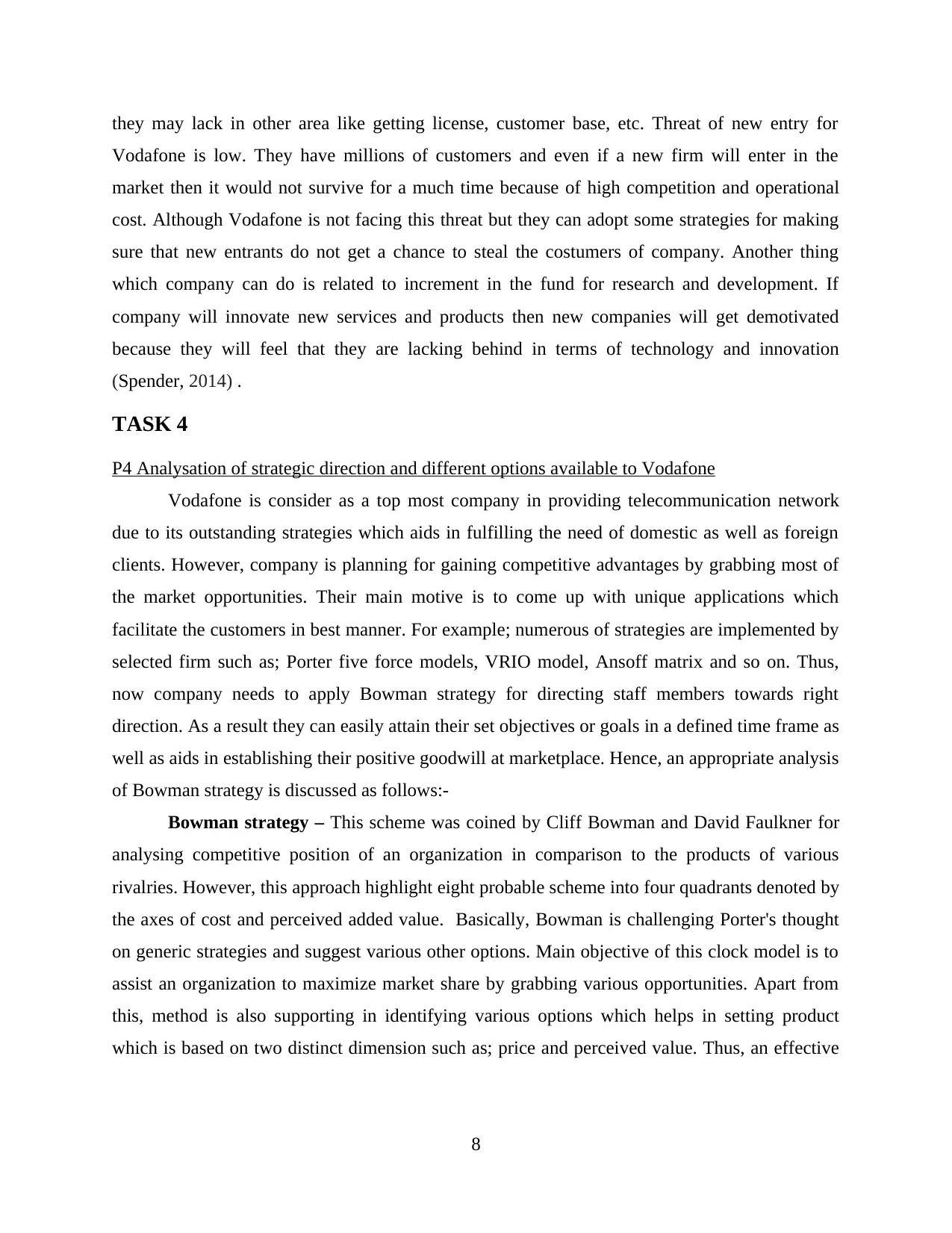
they may lack in other area like getting license, customer base, etc. Threat of new entry for
Vodafone is low. They have millions of customers and even if a new firm will enter in the
market then it would not survive for a much time because of high competition and operational
cost. Although Vodafone is not facing this threat but they can adopt some strategies for making
sure that new entrants do not get a chance to steal the costumers of company. Another thing
which company can do is related to increment in the fund for research and development. If
company will innovate new services and products then new companies will get demotivated
because they will feel that they are lacking behind in terms of technology and innovation
(Spender, 2014) .
TASK 4
P4 Analysation of strategic direction and different options available to Vodafone
Vodafone is consider as a top most company in providing telecommunication network
due to its outstanding strategies which aids in fulfilling the need of domestic as well as foreign
clients. However, company is planning for gaining competitive advantages by grabbing most of
the market opportunities. Their main motive is to come up with unique applications which
facilitate the customers in best manner. For example; numerous of strategies are implemented by
selected firm such as; Porter five force models, VRIO model, Ansoff matrix and so on. Thus,
now company needs to apply Bowman strategy for directing staff members towards right
direction. As a result they can easily attain their set objectives or goals in a defined time frame as
well as aids in establishing their positive goodwill at marketplace. Hence, an appropriate analysis
of Bowman strategy is discussed as follows:-
Bowman strategy – This scheme was coined by Cliff Bowman and David Faulkner for
analysing competitive position of an organization in comparison to the products of various
rivalries. However, this approach highlight eight probable scheme into four quadrants denoted by
the axes of cost and perceived added value. Basically, Bowman is challenging Porter's thought
on generic strategies and suggest various other options. Main objective of this clock model is to
assist an organization to maximize market share by grabbing various opportunities. Apart from
this, method is also supporting in identifying various options which helps in setting product
which is based on two distinct dimension such as; price and perceived value. Thus, an effective
8
Vodafone is low. They have millions of customers and even if a new firm will enter in the
market then it would not survive for a much time because of high competition and operational
cost. Although Vodafone is not facing this threat but they can adopt some strategies for making
sure that new entrants do not get a chance to steal the costumers of company. Another thing
which company can do is related to increment in the fund for research and development. If
company will innovate new services and products then new companies will get demotivated
because they will feel that they are lacking behind in terms of technology and innovation
(Spender, 2014) .
TASK 4
P4 Analysation of strategic direction and different options available to Vodafone
Vodafone is consider as a top most company in providing telecommunication network
due to its outstanding strategies which aids in fulfilling the need of domestic as well as foreign
clients. However, company is planning for gaining competitive advantages by grabbing most of
the market opportunities. Their main motive is to come up with unique applications which
facilitate the customers in best manner. For example; numerous of strategies are implemented by
selected firm such as; Porter five force models, VRIO model, Ansoff matrix and so on. Thus,
now company needs to apply Bowman strategy for directing staff members towards right
direction. As a result they can easily attain their set objectives or goals in a defined time frame as
well as aids in establishing their positive goodwill at marketplace. Hence, an appropriate analysis
of Bowman strategy is discussed as follows:-
Bowman strategy – This scheme was coined by Cliff Bowman and David Faulkner for
analysing competitive position of an organization in comparison to the products of various
rivalries. However, this approach highlight eight probable scheme into four quadrants denoted by
the axes of cost and perceived added value. Basically, Bowman is challenging Porter's thought
on generic strategies and suggest various other options. Main objective of this clock model is to
assist an organization to maximize market share by grabbing various opportunities. Apart from
this, method is also supporting in identifying various options which helps in setting product
which is based on two distinct dimension such as; price and perceived value. Thus, an effective
8
Paraphrase This Document
Need a fresh take? Get an instant paraphrase of this document with our AI Paraphraser
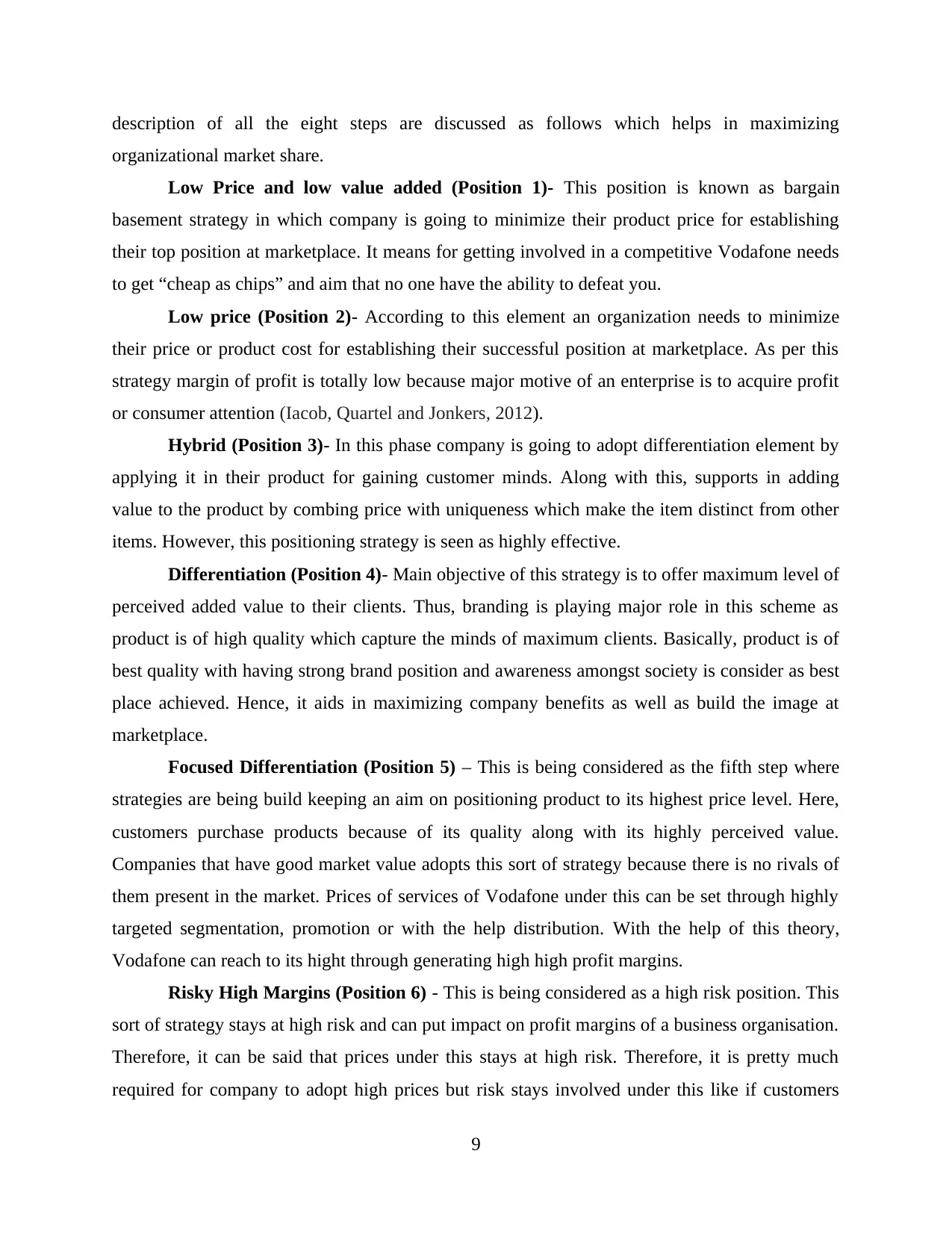
description of all the eight steps are discussed as follows which helps in maximizing
organizational market share.
Low Price and low value added (Position 1)- This position is known as bargain
basement strategy in which company is going to minimize their product price for establishing
their top position at marketplace. It means for getting involved in a competitive Vodafone needs
to get “cheap as chips” and aim that no one have the ability to defeat you.
Low price (Position 2)- According to this element an organization needs to minimize
their price or product cost for establishing their successful position at marketplace. As per this
strategy margin of profit is totally low because major motive of an enterprise is to acquire profit
or consumer attention (Iacob, Quartel and Jonkers, 2012).
Hybrid (Position 3)- In this phase company is going to adopt differentiation element by
applying it in their product for gaining customer minds. Along with this, supports in adding
value to the product by combing price with uniqueness which make the item distinct from other
items. However, this positioning strategy is seen as highly effective.
Differentiation (Position 4)- Main objective of this strategy is to offer maximum level of
perceived added value to their clients. Thus, branding is playing major role in this scheme as
product is of high quality which capture the minds of maximum clients. Basically, product is of
best quality with having strong brand position and awareness amongst society is consider as best
place achieved. Hence, it aids in maximizing company benefits as well as build the image at
marketplace.
Focused Differentiation (Position 5) – This is being considered as the fifth step where
strategies are being build keeping an aim on positioning product to its highest price level. Here,
customers purchase products because of its quality along with its highly perceived value.
Companies that have good market value adopts this sort of strategy because there is no rivals of
them present in the market. Prices of services of Vodafone under this can be set through highly
targeted segmentation, promotion or with the help distribution. With the help of this theory,
Vodafone can reach to its hight through generating high high profit margins.
Risky High Margins (Position 6) - This is being considered as a high risk position. This
sort of strategy stays at high risk and can put impact on profit margins of a business organisation.
Therefore, it can be said that prices under this stays at high risk. Therefore, it is pretty much
required for company to adopt high prices but risk stays involved under this like if customers
9
organizational market share.
Low Price and low value added (Position 1)- This position is known as bargain
basement strategy in which company is going to minimize their product price for establishing
their top position at marketplace. It means for getting involved in a competitive Vodafone needs
to get “cheap as chips” and aim that no one have the ability to defeat you.
Low price (Position 2)- According to this element an organization needs to minimize
their price or product cost for establishing their successful position at marketplace. As per this
strategy margin of profit is totally low because major motive of an enterprise is to acquire profit
or consumer attention (Iacob, Quartel and Jonkers, 2012).
Hybrid (Position 3)- In this phase company is going to adopt differentiation element by
applying it in their product for gaining customer minds. Along with this, supports in adding
value to the product by combing price with uniqueness which make the item distinct from other
items. However, this positioning strategy is seen as highly effective.
Differentiation (Position 4)- Main objective of this strategy is to offer maximum level of
perceived added value to their clients. Thus, branding is playing major role in this scheme as
product is of high quality which capture the minds of maximum clients. Basically, product is of
best quality with having strong brand position and awareness amongst society is consider as best
place achieved. Hence, it aids in maximizing company benefits as well as build the image at
marketplace.
Focused Differentiation (Position 5) – This is being considered as the fifth step where
strategies are being build keeping an aim on positioning product to its highest price level. Here,
customers purchase products because of its quality along with its highly perceived value.
Companies that have good market value adopts this sort of strategy because there is no rivals of
them present in the market. Prices of services of Vodafone under this can be set through highly
targeted segmentation, promotion or with the help distribution. With the help of this theory,
Vodafone can reach to its hight through generating high high profit margins.
Risky High Margins (Position 6) - This is being considered as a high risk position. This
sort of strategy stays at high risk and can put impact on profit margins of a business organisation.
Therefore, it can be said that prices under this stays at high risk. Therefore, it is pretty much
required for company to adopt high prices but risk stays involved under this like if customers
9
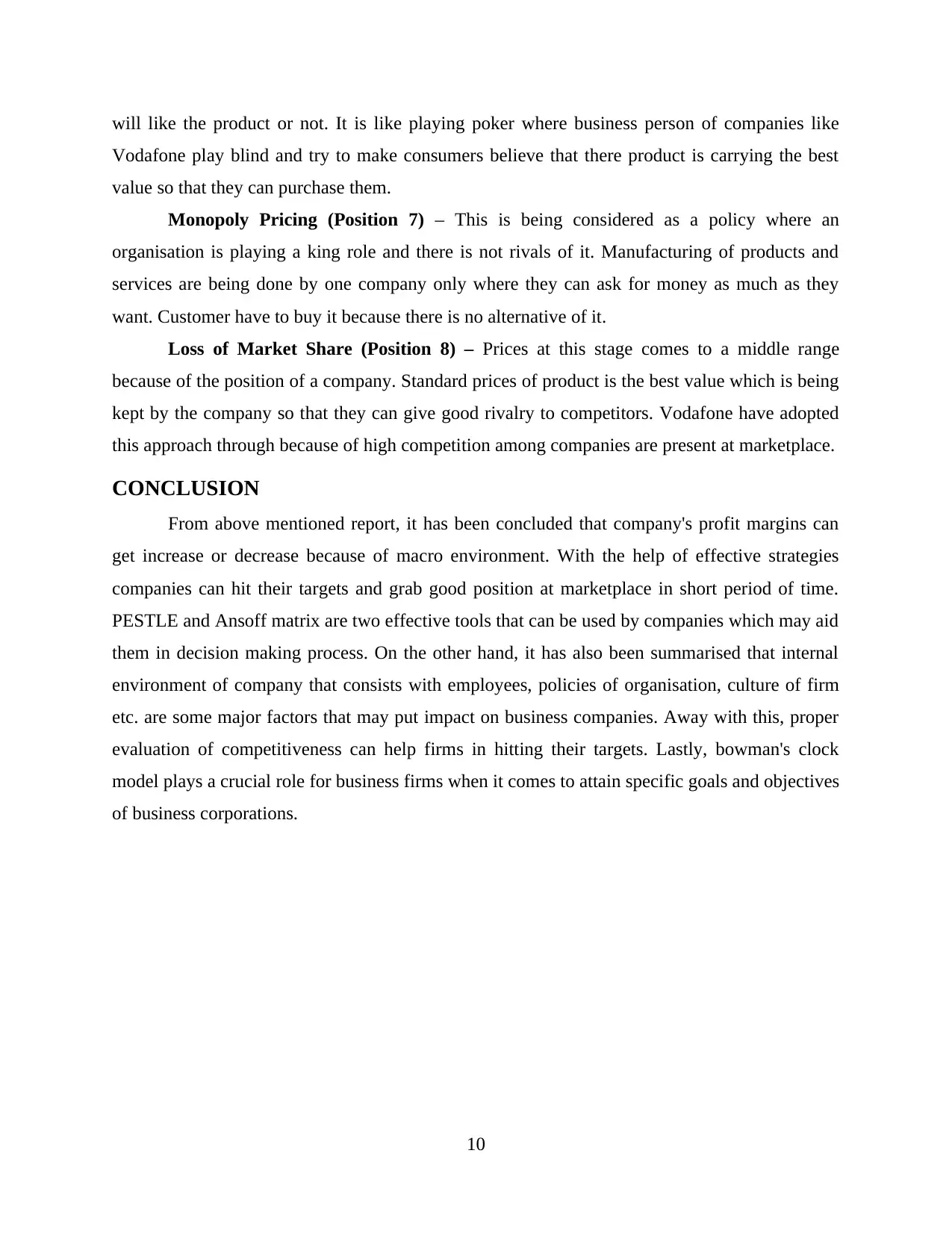
will like the product or not. It is like playing poker where business person of companies like
Vodafone play blind and try to make consumers believe that there product is carrying the best
value so that they can purchase them.
Monopoly Pricing (Position 7) – This is being considered as a policy where an
organisation is playing a king role and there is not rivals of it. Manufacturing of products and
services are being done by one company only where they can ask for money as much as they
want. Customer have to buy it because there is no alternative of it.
Loss of Market Share (Position 8) – Prices at this stage comes to a middle range
because of the position of a company. Standard prices of product is the best value which is being
kept by the company so that they can give good rivalry to competitors. Vodafone have adopted
this approach through because of high competition among companies are present at marketplace.
CONCLUSION
From above mentioned report, it has been concluded that company's profit margins can
get increase or decrease because of macro environment. With the help of effective strategies
companies can hit their targets and grab good position at marketplace in short period of time.
PESTLE and Ansoff matrix are two effective tools that can be used by companies which may aid
them in decision making process. On the other hand, it has also been summarised that internal
environment of company that consists with employees, policies of organisation, culture of firm
etc. are some major factors that may put impact on business companies. Away with this, proper
evaluation of competitiveness can help firms in hitting their targets. Lastly, bowman's clock
model plays a crucial role for business firms when it comes to attain specific goals and objectives
of business corporations.
10
Vodafone play blind and try to make consumers believe that there product is carrying the best
value so that they can purchase them.
Monopoly Pricing (Position 7) – This is being considered as a policy where an
organisation is playing a king role and there is not rivals of it. Manufacturing of products and
services are being done by one company only where they can ask for money as much as they
want. Customer have to buy it because there is no alternative of it.
Loss of Market Share (Position 8) – Prices at this stage comes to a middle range
because of the position of a company. Standard prices of product is the best value which is being
kept by the company so that they can give good rivalry to competitors. Vodafone have adopted
this approach through because of high competition among companies are present at marketplace.
CONCLUSION
From above mentioned report, it has been concluded that company's profit margins can
get increase or decrease because of macro environment. With the help of effective strategies
companies can hit their targets and grab good position at marketplace in short period of time.
PESTLE and Ansoff matrix are two effective tools that can be used by companies which may aid
them in decision making process. On the other hand, it has also been summarised that internal
environment of company that consists with employees, policies of organisation, culture of firm
etc. are some major factors that may put impact on business companies. Away with this, proper
evaluation of competitiveness can help firms in hitting their targets. Lastly, bowman's clock
model plays a crucial role for business firms when it comes to attain specific goals and objectives
of business corporations.
10
⊘ This is a preview!⊘
Do you want full access?
Subscribe today to unlock all pages.

Trusted by 1+ million students worldwide
1 out of 13
Related Documents
Your All-in-One AI-Powered Toolkit for Academic Success.
+13062052269
info@desklib.com
Available 24*7 on WhatsApp / Email
![[object Object]](/_next/static/media/star-bottom.7253800d.svg)
Unlock your academic potential
Copyright © 2020–2025 A2Z Services. All Rights Reserved. Developed and managed by ZUCOL.




